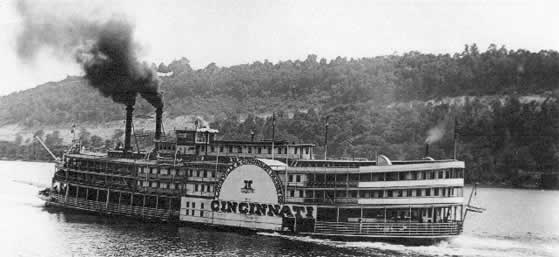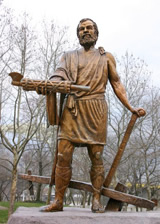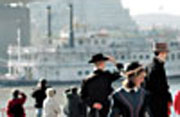 |
 |
 |
|
 |
||
| |
||
|
The Ohio Valley Regional Section is proud to welcome the USITT 2009 Annual Conference & Stage Expo to Cincinnati, Ohio. Be prepared for a wide variety of events in this exciting river city, March 18-21, 2009. Cincinnati gained its reputation as an exhibition town when it hosted the Annual Fair of the Ohio Mechanics Institute in 1838 -- a first in America. Because of its location, booming business, industry, and cultural institutions for art, literature, education, music, and theater, Cincinnati earned the title "The Queen City of the West" by the second quarter of the 19th century.
Having loyally served and successfully completed his mission in 16 days, he returned the symbol of power to the senate and returned home to his family and farm. He stands as the model citizen who will serve when called upon, but who favors the simple life of home and family over political power - a model for many citizens to this day.
Costumed volunteers (above) and re-enactors lent flavor to the 2006 Tall Stacks Event, commemorating the importance of inland riverboats to the development of Cincinnati.
Another, not as flattering a nickname, "Porkopolis" was due to the high number of slaughterhouses, sausage makers, and pork packers, not to mention the producers of byproducts like leather, bristle brushes, soap, and candles. Proctor & Gamble, founded in 1837, has direct links to pork through processing byproducts such as lard for use in making soap and candles. It is still one of the largest companies headquartered in Cincinnati. Most Amercian homes have at least one product developed and distributed by P&G for bath, kitchen, or laundry use. After the Civil War, a cultural explosion took place including the establishment of the Cincinnati Conservatory of Music, the Cincinnati Symphony Orchestra, the May Festival, the Art Museum and Art Academy, the Zoological Gardens, and the Public Library. These institutions thrive today providing entertainment as well as educational and employment opportunities for residents and visitors to the Greater Cincinnati area. For an interesting slide show of Sons and Daughters of Pioneer Rivermen, visit www.s-and-d.org/slideshow.htm. |
Full Steam
Ahead to Cincinnati in 2009 This image is one of many which can be found at the Cincinnati Library's Inland Riverboat Photograph Collection. |
|
 In 1788, John Filson named the first settlement Losantiville, meaning "town opposite the mouth of the Licking River." In 1790, General Arthur St. Claire, governor of the Northwest Territories, changed the name to commemorate the Society of Cincinnatus, the first hereditary military society in this country, whose members included George Washington and other military leaders involved in the Revolutionary War. The Society of Cincinnatus was named after Lucius Quintus Cincinnatus, a farmer who was given the status of dictator in order to lead the Roman army from an ambush during the early Roman Empire period. His statue, above, stands at Bicentennial Commons near the Ohio River. (Photo/Rick Dikeman)
In 1788, John Filson named the first settlement Losantiville, meaning "town opposite the mouth of the Licking River." In 1790, General Arthur St. Claire, governor of the Northwest Territories, changed the name to commemorate the Society of Cincinnatus, the first hereditary military society in this country, whose members included George Washington and other military leaders involved in the Revolutionary War. The Society of Cincinnatus was named after Lucius Quintus Cincinnatus, a farmer who was given the status of dictator in order to lead the Roman army from an ambush during the early Roman Empire period. His statue, above, stands at Bicentennial Commons near the Ohio River. (Photo/Rick Dikeman)  River transportation was responsible for the rapid growth of this town between 1830 and 1850 when it became the sixth largest city in the country and the third largest manufacturing center. Metal work and milling companies manufacturing tools for home and industry employed the most people in the area. Wood work and related businesses numbered 227 in 1841. Their products ranged from cabinets and furniture to circus wagons.
River transportation was responsible for the rapid growth of this town between 1830 and 1850 when it became the sixth largest city in the country and the third largest manufacturing center. Metal work and milling companies manufacturing tools for home and industry employed the most people in the area. Wood work and related businesses numbered 227 in 1841. Their products ranged from cabinets and furniture to circus wagons.  The National Steamboat Monument (right) at the Public Landing is a replica of the paddlewheel from the American Queen riverboat with working tall stacks that toot every minute. The buildings in the picture are actually digitized one inch to one foot painted elevations printed on vinyl and installed at the riverfront by 3dx Scenic Studio of Cincinnati, an ESTA member.
The National Steamboat Monument (right) at the Public Landing is a replica of the paddlewheel from the American Queen riverboat with working tall stacks that toot every minute. The buildings in the picture are actually digitized one inch to one foot painted elevations printed on vinyl and installed at the riverfront by 3dx Scenic Studio of Cincinnati, an ESTA member.